Food Safety Management: Preventing Contamination and Ensuring Safety
VerifiedAdded on 2020/06/04
|11
|3211
|76
Report
AI Summary
This report comprehensively examines food safety management, beginning with an introduction highlighting the importance of protecting food from contamination to prevent diseases and ensure consumer health. Task 1 delves into controls for preventing physical and chemical contamination, differentiating between food poisoning and foodborne infections, and discussing methods for controlling foodborne illnesses. Task 2 categorizes food spoilage agents and explores various food preservation methods, evaluating their effectiveness. Task 3 focuses on key steps in temperature control systems, safe food storage, the role of personal hygiene, cleaning and disinfection processes, pest control in food premises, hygienic design, and the importance of training as a quality assurance mechanism. Task 4 involves producing a food hazard risk assessment, completing a food safety control system, and devising a food safety guide for legislative compliance, culminating in a conclusion summarizing the key findings and recommendations. The report emphasizes the importance of food safety practices and provides practical insights into maintaining food safety standards.
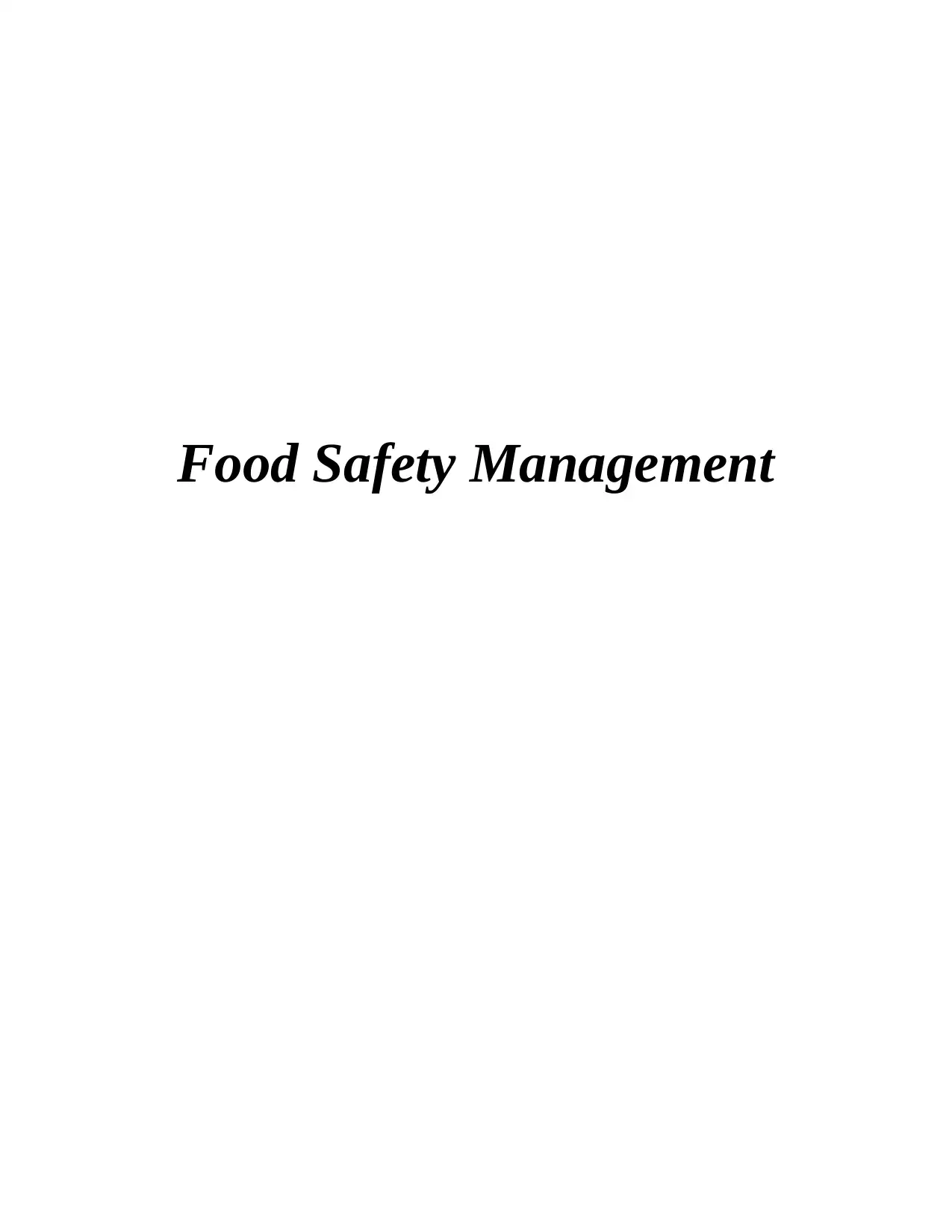
Food Safety Management
Paraphrase This Document
Need a fresh take? Get an instant paraphrase of this document with our AI Paraphraser
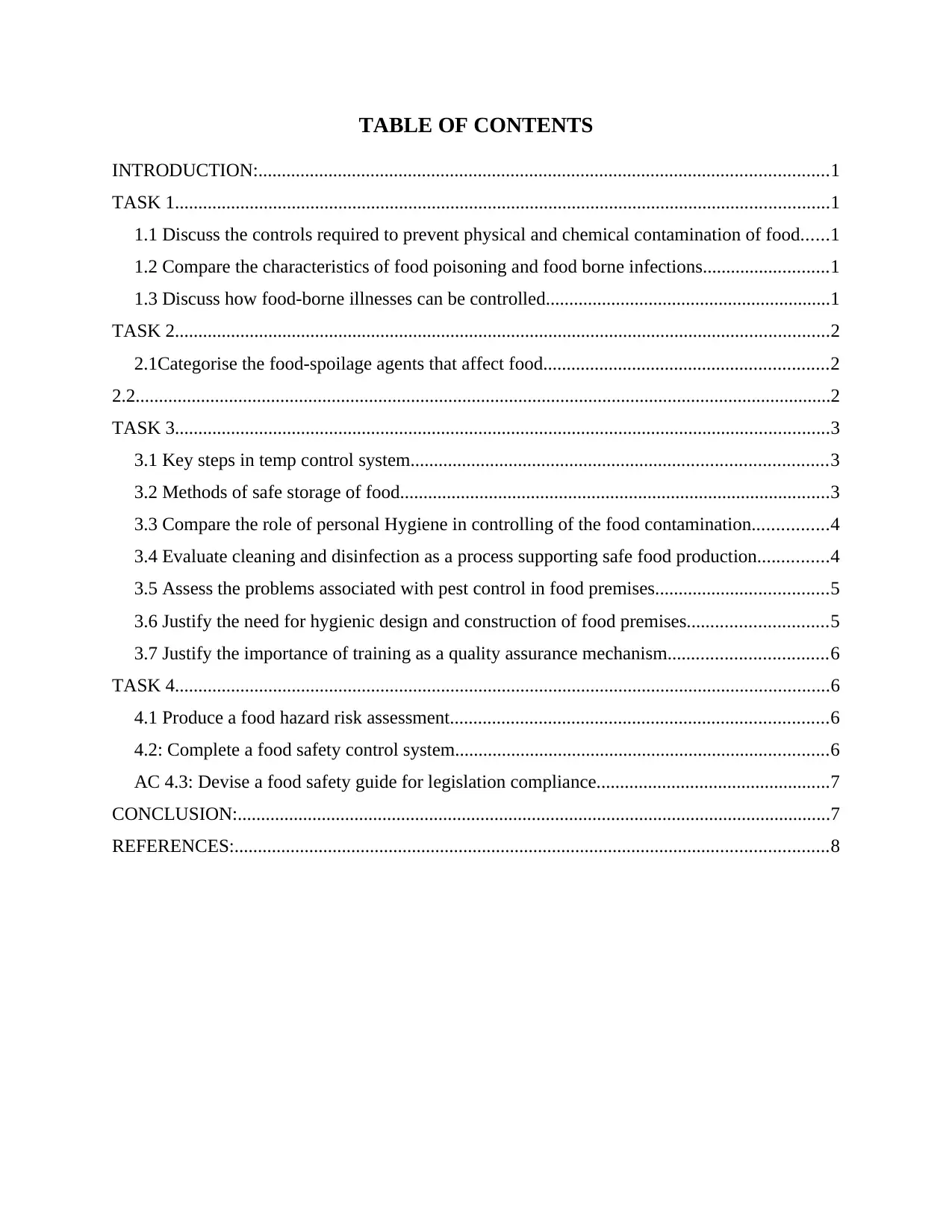
TABLE OF CONTENTS
INTRODUCTION:..........................................................................................................................1
TASK 1............................................................................................................................................1
1.1 Discuss the controls required to prevent physical and chemical contamination of food......1
1.2 Compare the characteristics of food poisoning and food borne infections...........................1
1.3 Discuss how food-borne illnesses can be controlled.............................................................1
TASK 2............................................................................................................................................2
2.1Categorise the food-spoilage agents that affect food.............................................................2
2.2.....................................................................................................................................................2
TASK 3............................................................................................................................................3
3.1 Key steps in temp control system.........................................................................................3
3.2 Methods of safe storage of food............................................................................................3
3.3 Compare the role of personal Hygiene in controlling of the food contamination................4
3.4 Evaluate cleaning and disinfection as a process supporting safe food production...............4
3.5 Assess the problems associated with pest control in food premises.....................................5
3.6 Justify the need for hygienic design and construction of food premises..............................5
3.7 Justify the importance of training as a quality assurance mechanism..................................6
TASK 4............................................................................................................................................6
4.1 Produce a food hazard risk assessment.................................................................................6
4.2: Complete a food safety control system................................................................................6
AC 4.3: Devise a food safety guide for legislation compliance..................................................7
CONCLUSION:...............................................................................................................................7
REFERENCES:...............................................................................................................................8
INTRODUCTION:..........................................................................................................................1
TASK 1............................................................................................................................................1
1.1 Discuss the controls required to prevent physical and chemical contamination of food......1
1.2 Compare the characteristics of food poisoning and food borne infections...........................1
1.3 Discuss how food-borne illnesses can be controlled.............................................................1
TASK 2............................................................................................................................................2
2.1Categorise the food-spoilage agents that affect food.............................................................2
2.2.....................................................................................................................................................2
TASK 3............................................................................................................................................3
3.1 Key steps in temp control system.........................................................................................3
3.2 Methods of safe storage of food............................................................................................3
3.3 Compare the role of personal Hygiene in controlling of the food contamination................4
3.4 Evaluate cleaning and disinfection as a process supporting safe food production...............4
3.5 Assess the problems associated with pest control in food premises.....................................5
3.6 Justify the need for hygienic design and construction of food premises..............................5
3.7 Justify the importance of training as a quality assurance mechanism..................................6
TASK 4............................................................................................................................................6
4.1 Produce a food hazard risk assessment.................................................................................6
4.2: Complete a food safety control system................................................................................6
AC 4.3: Devise a food safety guide for legislation compliance..................................................7
CONCLUSION:...............................................................................................................................7
REFERENCES:...............................................................................................................................8
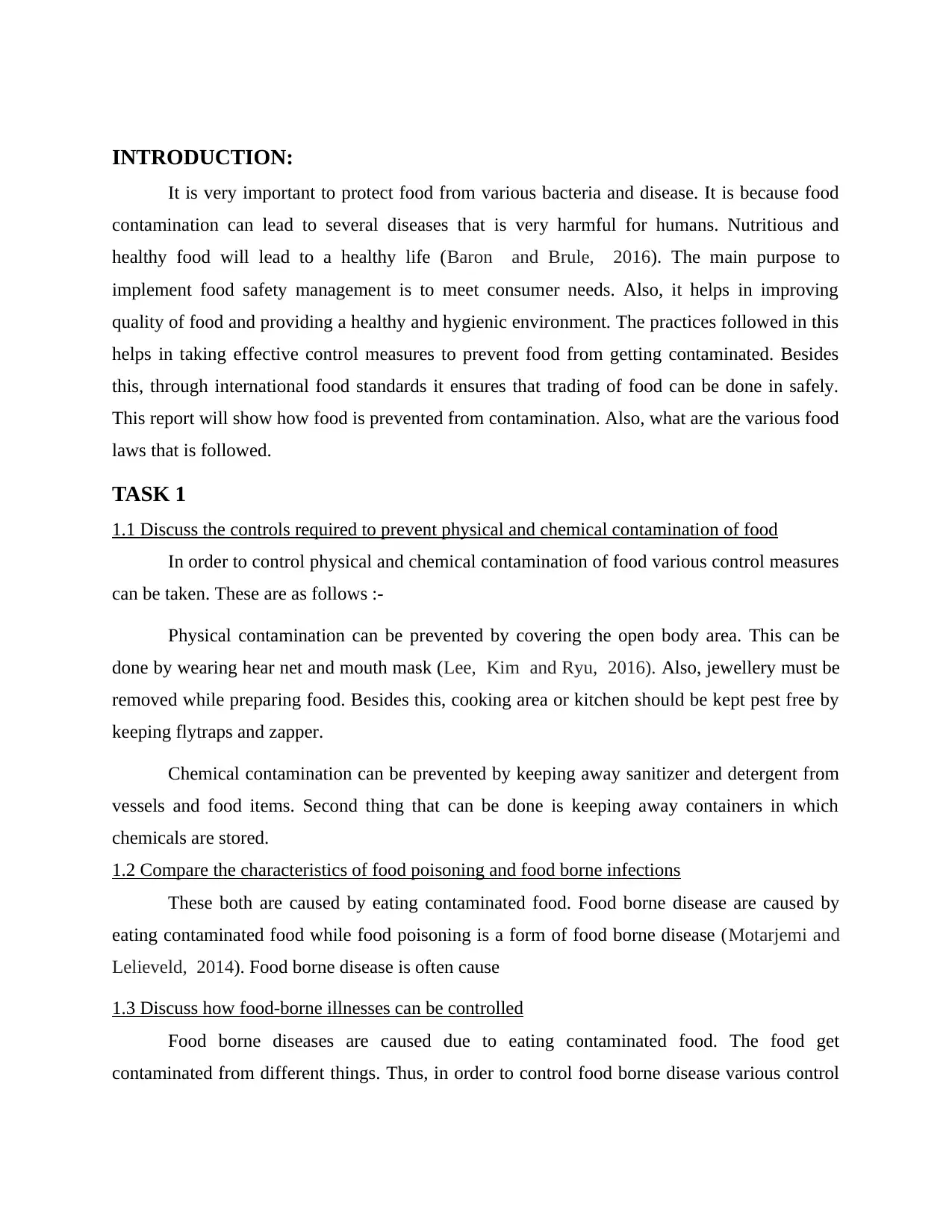
INTRODUCTION:
It is very important to protect food from various bacteria and disease. It is because food
contamination can lead to several diseases that is very harmful for humans. Nutritious and
healthy food will lead to a healthy life (Baron and Brule, 2016). The main purpose to
implement food safety management is to meet consumer needs. Also, it helps in improving
quality of food and providing a healthy and hygienic environment. The practices followed in this
helps in taking effective control measures to prevent food from getting contaminated. Besides
this, through international food standards it ensures that trading of food can be done in safely.
This report will show how food is prevented from contamination. Also, what are the various food
laws that is followed.
TASK 1
1.1 Discuss the controls required to prevent physical and chemical contamination of food
In order to control physical and chemical contamination of food various control measures
can be taken. These are as follows :-
Physical contamination can be prevented by covering the open body area. This can be
done by wearing hear net and mouth mask (Lee, Kim and Ryu, 2016). Also, jewellery must be
removed while preparing food. Besides this, cooking area or kitchen should be kept pest free by
keeping flytraps and zapper.
Chemical contamination can be prevented by keeping away sanitizer and detergent from
vessels and food items. Second thing that can be done is keeping away containers in which
chemicals are stored.
1.2 Compare the characteristics of food poisoning and food borne infections
These both are caused by eating contaminated food. Food borne disease are caused by
eating contaminated food while food poisoning is a form of food borne disease (Motarjemi and
Lelieveld, 2014). Food borne disease is often cause
1.3 Discuss how food-borne illnesses can be controlled
Food borne diseases are caused due to eating contaminated food. The food get
contaminated from different things. Thus, in order to control food borne disease various control
It is very important to protect food from various bacteria and disease. It is because food
contamination can lead to several diseases that is very harmful for humans. Nutritious and
healthy food will lead to a healthy life (Baron and Brule, 2016). The main purpose to
implement food safety management is to meet consumer needs. Also, it helps in improving
quality of food and providing a healthy and hygienic environment. The practices followed in this
helps in taking effective control measures to prevent food from getting contaminated. Besides
this, through international food standards it ensures that trading of food can be done in safely.
This report will show how food is prevented from contamination. Also, what are the various food
laws that is followed.
TASK 1
1.1 Discuss the controls required to prevent physical and chemical contamination of food
In order to control physical and chemical contamination of food various control measures
can be taken. These are as follows :-
Physical contamination can be prevented by covering the open body area. This can be
done by wearing hear net and mouth mask (Lee, Kim and Ryu, 2016). Also, jewellery must be
removed while preparing food. Besides this, cooking area or kitchen should be kept pest free by
keeping flytraps and zapper.
Chemical contamination can be prevented by keeping away sanitizer and detergent from
vessels and food items. Second thing that can be done is keeping away containers in which
chemicals are stored.
1.2 Compare the characteristics of food poisoning and food borne infections
These both are caused by eating contaminated food. Food borne disease are caused by
eating contaminated food while food poisoning is a form of food borne disease (Motarjemi and
Lelieveld, 2014). Food borne disease is often cause
1.3 Discuss how food-borne illnesses can be controlled
Food borne diseases are caused due to eating contaminated food. The food get
contaminated from different things. Thus, in order to control food borne disease various control
⊘ This is a preview!⊘
Do you want full access?
Subscribe today to unlock all pages.

Trusted by 1+ million students worldwide
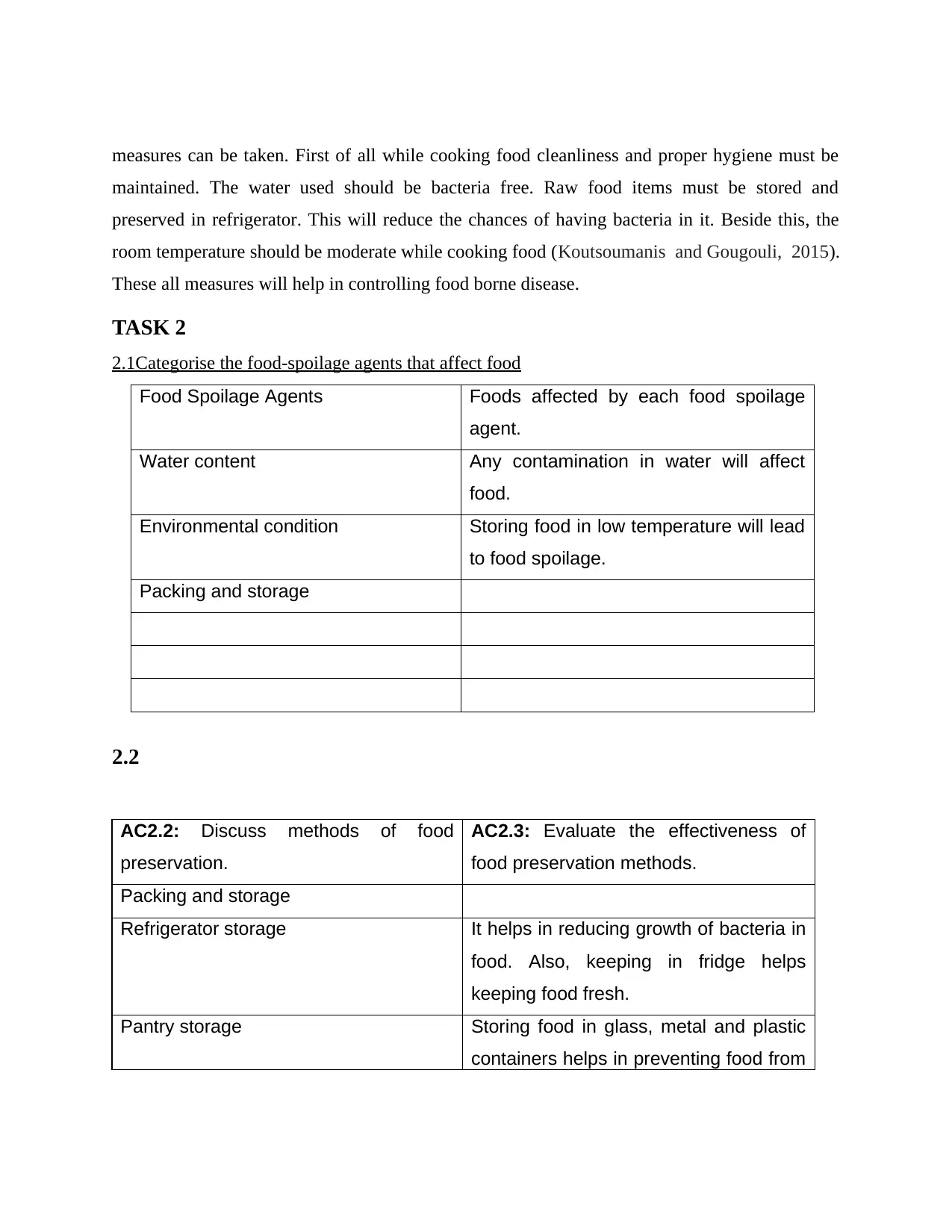
measures can be taken. First of all while cooking food cleanliness and proper hygiene must be
maintained. The water used should be bacteria free. Raw food items must be stored and
preserved in refrigerator. This will reduce the chances of having bacteria in it. Beside this, the
room temperature should be moderate while cooking food (Koutsoumanis and Gougouli, 2015).
These all measures will help in controlling food borne disease.
TASK 2
2.1Categorise the food-spoilage agents that affect food
Food Spoilage Agents Foods affected by each food spoilage
agent.
Water content Any contamination in water will affect
food.
Environmental condition Storing food in low temperature will lead
to food spoilage.
Packing and storage
2.2
AC2.2: Discuss methods of food
preservation.
AC2.3: Evaluate the effectiveness of
food preservation methods.
Packing and storage
Refrigerator storage It helps in reducing growth of bacteria in
food. Also, keeping in fridge helps
keeping food fresh.
Pantry storage Storing food in glass, metal and plastic
containers helps in preventing food from
maintained. The water used should be bacteria free. Raw food items must be stored and
preserved in refrigerator. This will reduce the chances of having bacteria in it. Beside this, the
room temperature should be moderate while cooking food (Koutsoumanis and Gougouli, 2015).
These all measures will help in controlling food borne disease.
TASK 2
2.1Categorise the food-spoilage agents that affect food
Food Spoilage Agents Foods affected by each food spoilage
agent.
Water content Any contamination in water will affect
food.
Environmental condition Storing food in low temperature will lead
to food spoilage.
Packing and storage
2.2
AC2.2: Discuss methods of food
preservation.
AC2.3: Evaluate the effectiveness of
food preservation methods.
Packing and storage
Refrigerator storage It helps in reducing growth of bacteria in
food. Also, keeping in fridge helps
keeping food fresh.
Pantry storage Storing food in glass, metal and plastic
containers helps in preventing food from
Paraphrase This Document
Need a fresh take? Get an instant paraphrase of this document with our AI Paraphraser
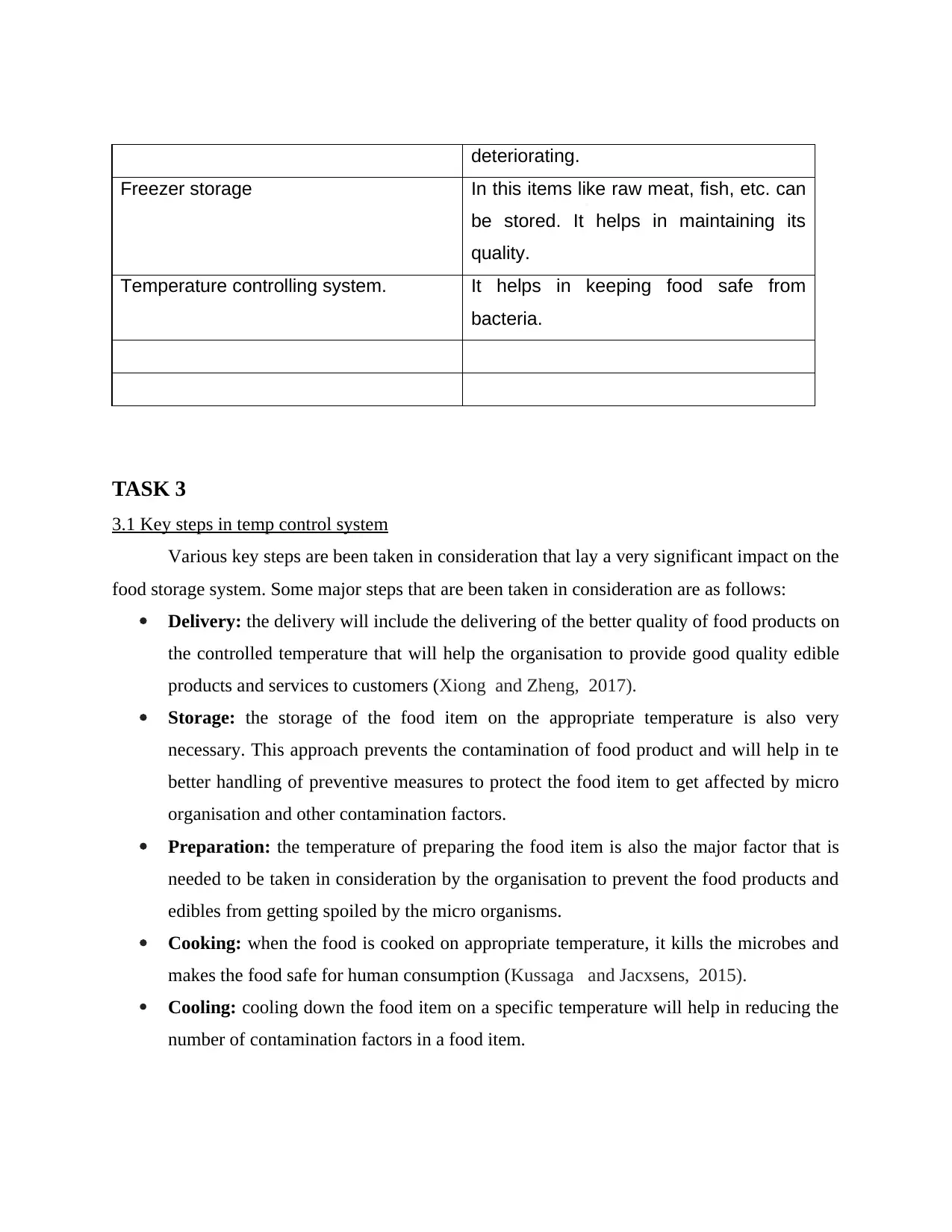
deteriorating.
Freezer storage In this items like raw meat, fish, etc. can
be stored. It helps in maintaining its
quality.
Temperature controlling system. It helps in keeping food safe from
bacteria.
TASK 3
3.1 Key steps in temp control system
Various key steps are been taken in consideration that lay a very significant impact on the
food storage system. Some major steps that are been taken in consideration are as follows:
Delivery: the delivery will include the delivering of the better quality of food products on
the controlled temperature that will help the organisation to provide good quality edible
products and services to customers (Xiong and Zheng, 2017).
Storage: the storage of the food item on the appropriate temperature is also very
necessary. This approach prevents the contamination of food product and will help in te
better handling of preventive measures to protect the food item to get affected by micro
organisation and other contamination factors.
Preparation: the temperature of preparing the food item is also the major factor that is
needed to be taken in consideration by the organisation to prevent the food products and
edibles from getting spoiled by the micro organisms.
Cooking: when the food is cooked on appropriate temperature, it kills the microbes and
makes the food safe for human consumption (Kussaga and Jacxsens, 2015).
Cooling: cooling down the food item on a specific temperature will help in reducing the
number of contamination factors in a food item.
Freezer storage In this items like raw meat, fish, etc. can
be stored. It helps in maintaining its
quality.
Temperature controlling system. It helps in keeping food safe from
bacteria.
TASK 3
3.1 Key steps in temp control system
Various key steps are been taken in consideration that lay a very significant impact on the
food storage system. Some major steps that are been taken in consideration are as follows:
Delivery: the delivery will include the delivering of the better quality of food products on
the controlled temperature that will help the organisation to provide good quality edible
products and services to customers (Xiong and Zheng, 2017).
Storage: the storage of the food item on the appropriate temperature is also very
necessary. This approach prevents the contamination of food product and will help in te
better handling of preventive measures to protect the food item to get affected by micro
organisation and other contamination factors.
Preparation: the temperature of preparing the food item is also the major factor that is
needed to be taken in consideration by the organisation to prevent the food products and
edibles from getting spoiled by the micro organisms.
Cooking: when the food is cooked on appropriate temperature, it kills the microbes and
makes the food safe for human consumption (Kussaga and Jacxsens, 2015).
Cooling: cooling down the food item on a specific temperature will help in reducing the
number of contamination factors in a food item.
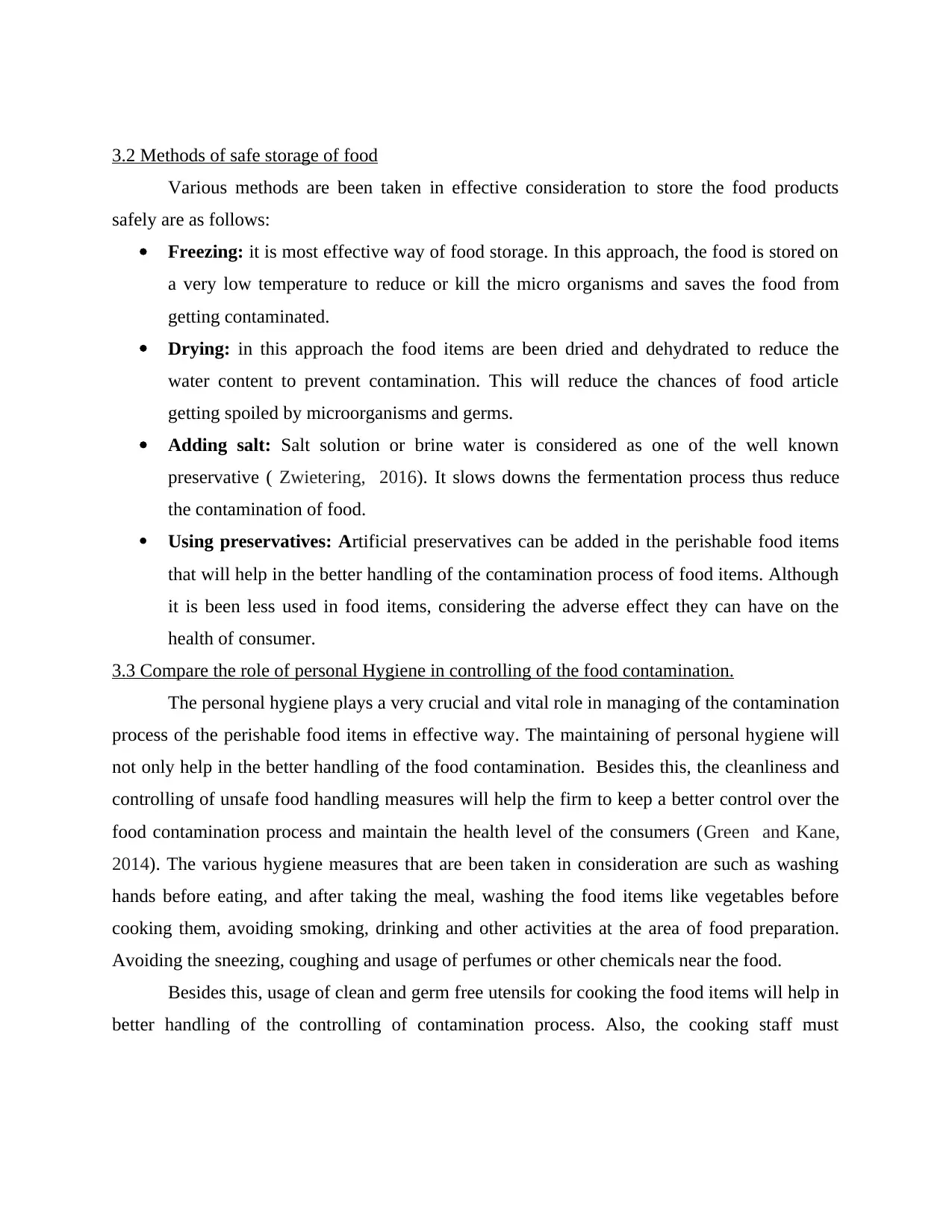
3.2 Methods of safe storage of food
Various methods are been taken in effective consideration to store the food products
safely are as follows:
Freezing: it is most effective way of food storage. In this approach, the food is stored on
a very low temperature to reduce or kill the micro organisms and saves the food from
getting contaminated.
Drying: in this approach the food items are been dried and dehydrated to reduce the
water content to prevent contamination. This will reduce the chances of food article
getting spoiled by microorganisms and germs.
Adding salt: Salt solution or brine water is considered as one of the well known
preservative ( Zwietering, 2016). It slows downs the fermentation process thus reduce
the contamination of food.
Using preservatives: Artificial preservatives can be added in the perishable food items
that will help in the better handling of the contamination process of food items. Although
it is been less used in food items, considering the adverse effect they can have on the
health of consumer.
3.3 Compare the role of personal Hygiene in controlling of the food contamination.
The personal hygiene plays a very crucial and vital role in managing of the contamination
process of the perishable food items in effective way. The maintaining of personal hygiene will
not only help in the better handling of the food contamination. Besides this, the cleanliness and
controlling of unsafe food handling measures will help the firm to keep a better control over the
food contamination process and maintain the health level of the consumers (Green and Kane,
2014). The various hygiene measures that are been taken in consideration are such as washing
hands before eating, and after taking the meal, washing the food items like vegetables before
cooking them, avoiding smoking, drinking and other activities at the area of food preparation.
Avoiding the sneezing, coughing and usage of perfumes or other chemicals near the food.
Besides this, usage of clean and germ free utensils for cooking the food items will help in
better handling of the controlling of contamination process. Also, the cooking staff must
Various methods are been taken in effective consideration to store the food products
safely are as follows:
Freezing: it is most effective way of food storage. In this approach, the food is stored on
a very low temperature to reduce or kill the micro organisms and saves the food from
getting contaminated.
Drying: in this approach the food items are been dried and dehydrated to reduce the
water content to prevent contamination. This will reduce the chances of food article
getting spoiled by microorganisms and germs.
Adding salt: Salt solution or brine water is considered as one of the well known
preservative ( Zwietering, 2016). It slows downs the fermentation process thus reduce
the contamination of food.
Using preservatives: Artificial preservatives can be added in the perishable food items
that will help in the better handling of the contamination process of food items. Although
it is been less used in food items, considering the adverse effect they can have on the
health of consumer.
3.3 Compare the role of personal Hygiene in controlling of the food contamination.
The personal hygiene plays a very crucial and vital role in managing of the contamination
process of the perishable food items in effective way. The maintaining of personal hygiene will
not only help in the better handling of the food contamination. Besides this, the cleanliness and
controlling of unsafe food handling measures will help the firm to keep a better control over the
food contamination process and maintain the health level of the consumers (Green and Kane,
2014). The various hygiene measures that are been taken in consideration are such as washing
hands before eating, and after taking the meal, washing the food items like vegetables before
cooking them, avoiding smoking, drinking and other activities at the area of food preparation.
Avoiding the sneezing, coughing and usage of perfumes or other chemicals near the food.
Besides this, usage of clean and germ free utensils for cooking the food items will help in
better handling of the controlling of contamination process. Also, the cooking staff must
⊘ This is a preview!⊘
Do you want full access?
Subscribe today to unlock all pages.

Trusted by 1+ million students worldwide
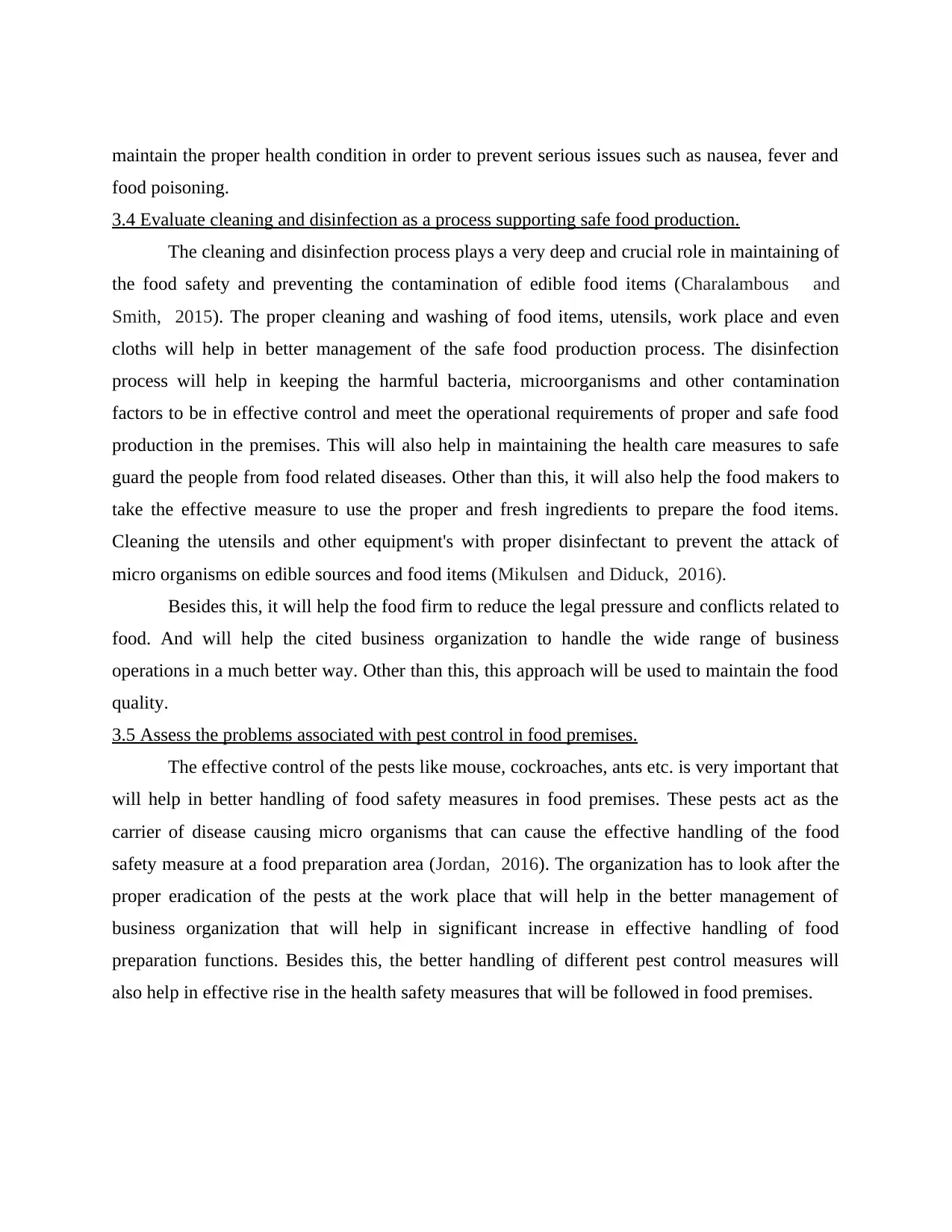
maintain the proper health condition in order to prevent serious issues such as nausea, fever and
food poisoning.
3.4 Evaluate cleaning and disinfection as a process supporting safe food production.
The cleaning and disinfection process plays a very deep and crucial role in maintaining of
the food safety and preventing the contamination of edible food items (Charalambous and
Smith, 2015). The proper cleaning and washing of food items, utensils, work place and even
cloths will help in better management of the safe food production process. The disinfection
process will help in keeping the harmful bacteria, microorganisms and other contamination
factors to be in effective control and meet the operational requirements of proper and safe food
production in the premises. This will also help in maintaining the health care measures to safe
guard the people from food related diseases. Other than this, it will also help the food makers to
take the effective measure to use the proper and fresh ingredients to prepare the food items.
Cleaning the utensils and other equipment's with proper disinfectant to prevent the attack of
micro organisms on edible sources and food items (Mikulsen and Diduck, 2016).
Besides this, it will help the food firm to reduce the legal pressure and conflicts related to
food. And will help the cited business organization to handle the wide range of business
operations in a much better way. Other than this, this approach will be used to maintain the food
quality.
3.5 Assess the problems associated with pest control in food premises.
The effective control of the pests like mouse, cockroaches, ants etc. is very important that
will help in better handling of food safety measures in food premises. These pests act as the
carrier of disease causing micro organisms that can cause the effective handling of the food
safety measure at a food preparation area (Jordan, 2016). The organization has to look after the
proper eradication of the pests at the work place that will help in the better management of
business organization that will help in significant increase in effective handling of food
preparation functions. Besides this, the better handling of different pest control measures will
also help in effective rise in the health safety measures that will be followed in food premises.
food poisoning.
3.4 Evaluate cleaning and disinfection as a process supporting safe food production.
The cleaning and disinfection process plays a very deep and crucial role in maintaining of
the food safety and preventing the contamination of edible food items (Charalambous and
Smith, 2015). The proper cleaning and washing of food items, utensils, work place and even
cloths will help in better management of the safe food production process. The disinfection
process will help in keeping the harmful bacteria, microorganisms and other contamination
factors to be in effective control and meet the operational requirements of proper and safe food
production in the premises. This will also help in maintaining the health care measures to safe
guard the people from food related diseases. Other than this, it will also help the food makers to
take the effective measure to use the proper and fresh ingredients to prepare the food items.
Cleaning the utensils and other equipment's with proper disinfectant to prevent the attack of
micro organisms on edible sources and food items (Mikulsen and Diduck, 2016).
Besides this, it will help the food firm to reduce the legal pressure and conflicts related to
food. And will help the cited business organization to handle the wide range of business
operations in a much better way. Other than this, this approach will be used to maintain the food
quality.
3.5 Assess the problems associated with pest control in food premises.
The effective control of the pests like mouse, cockroaches, ants etc. is very important that
will help in better handling of food safety measures in food premises. These pests act as the
carrier of disease causing micro organisms that can cause the effective handling of the food
safety measure at a food preparation area (Jordan, 2016). The organization has to look after the
proper eradication of the pests at the work place that will help in the better management of
business organization that will help in significant increase in effective handling of food
preparation functions. Besides this, the better handling of different pest control measures will
also help in effective rise in the health safety measures that will be followed in food premises.
Paraphrase This Document
Need a fresh take? Get an instant paraphrase of this document with our AI Paraphraser
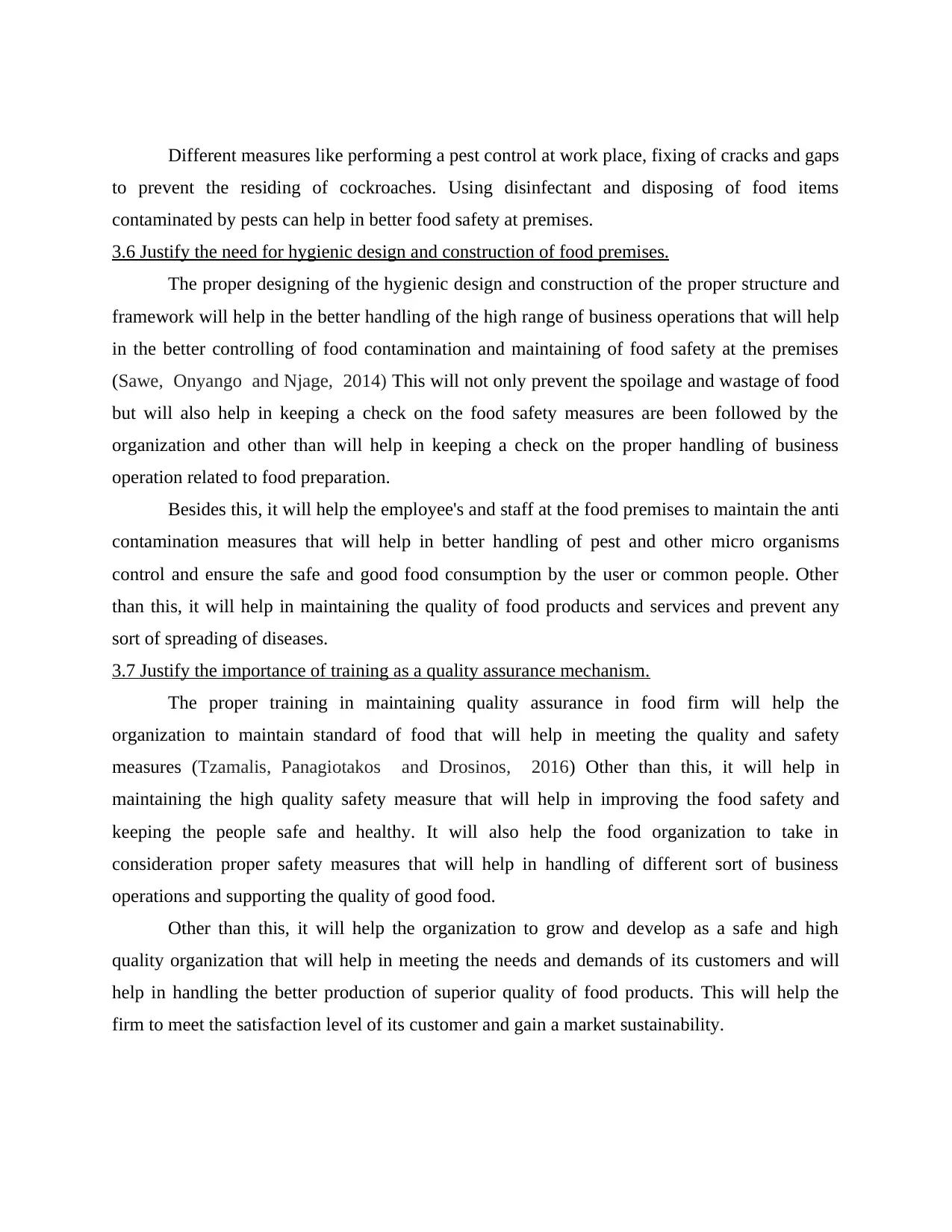
Different measures like performing a pest control at work place, fixing of cracks and gaps
to prevent the residing of cockroaches. Using disinfectant and disposing of food items
contaminated by pests can help in better food safety at premises.
3.6 Justify the need for hygienic design and construction of food premises.
The proper designing of the hygienic design and construction of the proper structure and
framework will help in the better handling of the high range of business operations that will help
in the better controlling of food contamination and maintaining of food safety at the premises
(Sawe, Onyango and Njage, 2014) This will not only prevent the spoilage and wastage of food
but will also help in keeping a check on the food safety measures are been followed by the
organization and other than will help in keeping a check on the proper handling of business
operation related to food preparation.
Besides this, it will help the employee's and staff at the food premises to maintain the anti
contamination measures that will help in better handling of pest and other micro organisms
control and ensure the safe and good food consumption by the user or common people. Other
than this, it will help in maintaining the quality of food products and services and prevent any
sort of spreading of diseases.
3.7 Justify the importance of training as a quality assurance mechanism.
The proper training in maintaining quality assurance in food firm will help the
organization to maintain standard of food that will help in meeting the quality and safety
measures (Tzamalis, Panagiotakos and Drosinos, 2016) Other than this, it will help in
maintaining the high quality safety measure that will help in improving the food safety and
keeping the people safe and healthy. It will also help the food organization to take in
consideration proper safety measures that will help in handling of different sort of business
operations and supporting the quality of good food.
Other than this, it will help the organization to grow and develop as a safe and high
quality organization that will help in meeting the needs and demands of its customers and will
help in handling the better production of superior quality of food products. This will help the
firm to meet the satisfaction level of its customer and gain a market sustainability.
to prevent the residing of cockroaches. Using disinfectant and disposing of food items
contaminated by pests can help in better food safety at premises.
3.6 Justify the need for hygienic design and construction of food premises.
The proper designing of the hygienic design and construction of the proper structure and
framework will help in the better handling of the high range of business operations that will help
in the better controlling of food contamination and maintaining of food safety at the premises
(Sawe, Onyango and Njage, 2014) This will not only prevent the spoilage and wastage of food
but will also help in keeping a check on the food safety measures are been followed by the
organization and other than will help in keeping a check on the proper handling of business
operation related to food preparation.
Besides this, it will help the employee's and staff at the food premises to maintain the anti
contamination measures that will help in better handling of pest and other micro organisms
control and ensure the safe and good food consumption by the user or common people. Other
than this, it will help in maintaining the quality of food products and services and prevent any
sort of spreading of diseases.
3.7 Justify the importance of training as a quality assurance mechanism.
The proper training in maintaining quality assurance in food firm will help the
organization to maintain standard of food that will help in meeting the quality and safety
measures (Tzamalis, Panagiotakos and Drosinos, 2016) Other than this, it will help in
maintaining the high quality safety measure that will help in improving the food safety and
keeping the people safe and healthy. It will also help the food organization to take in
consideration proper safety measures that will help in handling of different sort of business
operations and supporting the quality of good food.
Other than this, it will help the organization to grow and develop as a safe and high
quality organization that will help in meeting the needs and demands of its customers and will
help in handling the better production of superior quality of food products. This will help the
firm to meet the satisfaction level of its customer and gain a market sustainability.
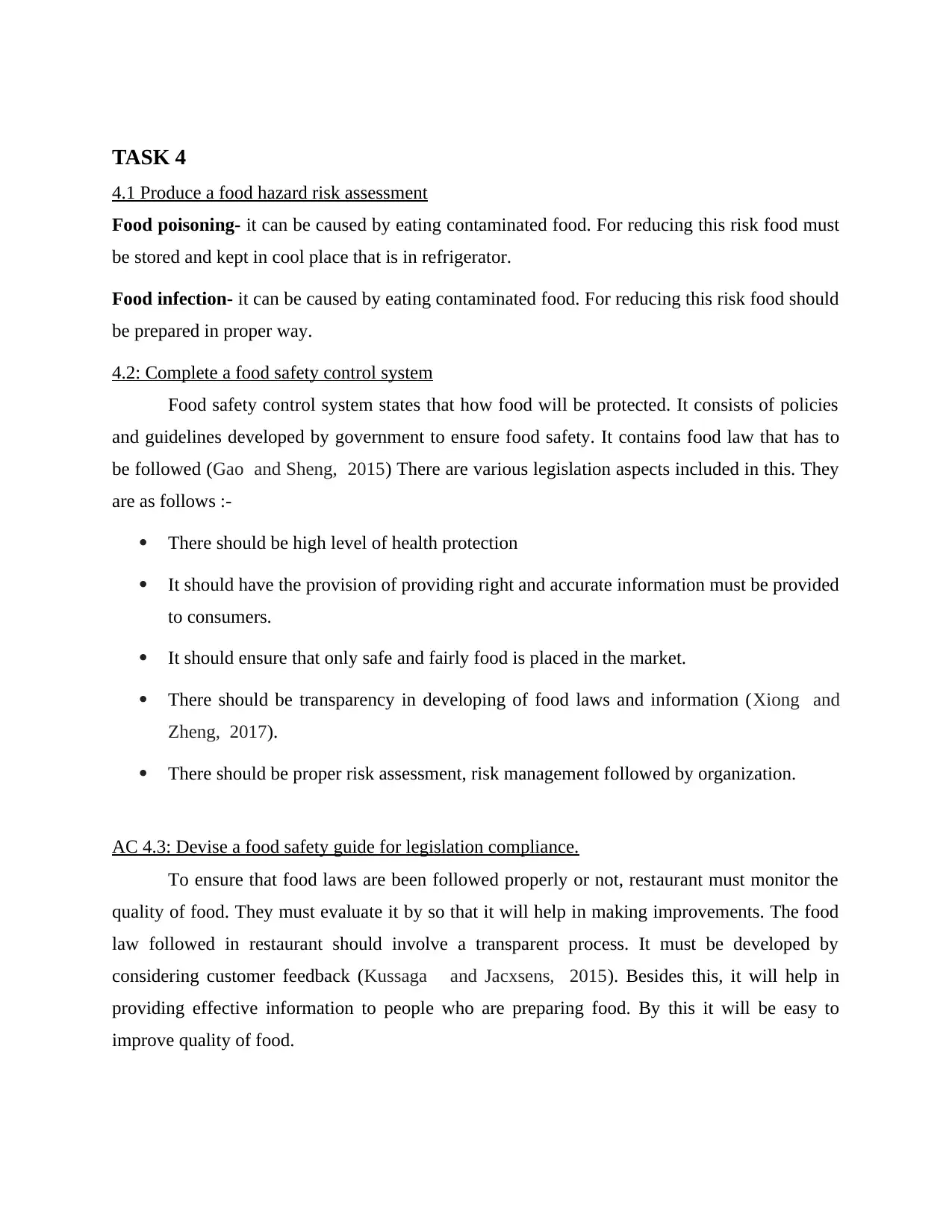
TASK 4
4.1 Produce a food hazard risk assessment
Food poisoning- it can be caused by eating contaminated food. For reducing this risk food must
be stored and kept in cool place that is in refrigerator.
Food infection- it can be caused by eating contaminated food. For reducing this risk food should
be prepared in proper way.
4.2: Complete a food safety control system
Food safety control system states that how food will be protected. It consists of policies
and guidelines developed by government to ensure food safety. It contains food law that has to
be followed (Gao and Sheng, 2015) There are various legislation aspects included in this. They
are as follows :-
There should be high level of health protection
It should have the provision of providing right and accurate information must be provided
to consumers.
It should ensure that only safe and fairly food is placed in the market.
There should be transparency in developing of food laws and information (Xiong and
Zheng, 2017).
There should be proper risk assessment, risk management followed by organization.
AC 4.3: Devise a food safety guide for legislation compliance.
To ensure that food laws are been followed properly or not, restaurant must monitor the
quality of food. They must evaluate it by so that it will help in making improvements. The food
law followed in restaurant should involve a transparent process. It must be developed by
considering customer feedback (Kussaga and Jacxsens, 2015). Besides this, it will help in
providing effective information to people who are preparing food. By this it will be easy to
improve quality of food.
4.1 Produce a food hazard risk assessment
Food poisoning- it can be caused by eating contaminated food. For reducing this risk food must
be stored and kept in cool place that is in refrigerator.
Food infection- it can be caused by eating contaminated food. For reducing this risk food should
be prepared in proper way.
4.2: Complete a food safety control system
Food safety control system states that how food will be protected. It consists of policies
and guidelines developed by government to ensure food safety. It contains food law that has to
be followed (Gao and Sheng, 2015) There are various legislation aspects included in this. They
are as follows :-
There should be high level of health protection
It should have the provision of providing right and accurate information must be provided
to consumers.
It should ensure that only safe and fairly food is placed in the market.
There should be transparency in developing of food laws and information (Xiong and
Zheng, 2017).
There should be proper risk assessment, risk management followed by organization.
AC 4.3: Devise a food safety guide for legislation compliance.
To ensure that food laws are been followed properly or not, restaurant must monitor the
quality of food. They must evaluate it by so that it will help in making improvements. The food
law followed in restaurant should involve a transparent process. It must be developed by
considering customer feedback (Kussaga and Jacxsens, 2015). Besides this, it will help in
providing effective information to people who are preparing food. By this it will be easy to
improve quality of food.
⊘ This is a preview!⊘
Do you want full access?
Subscribe today to unlock all pages.

Trusted by 1+ million students worldwide
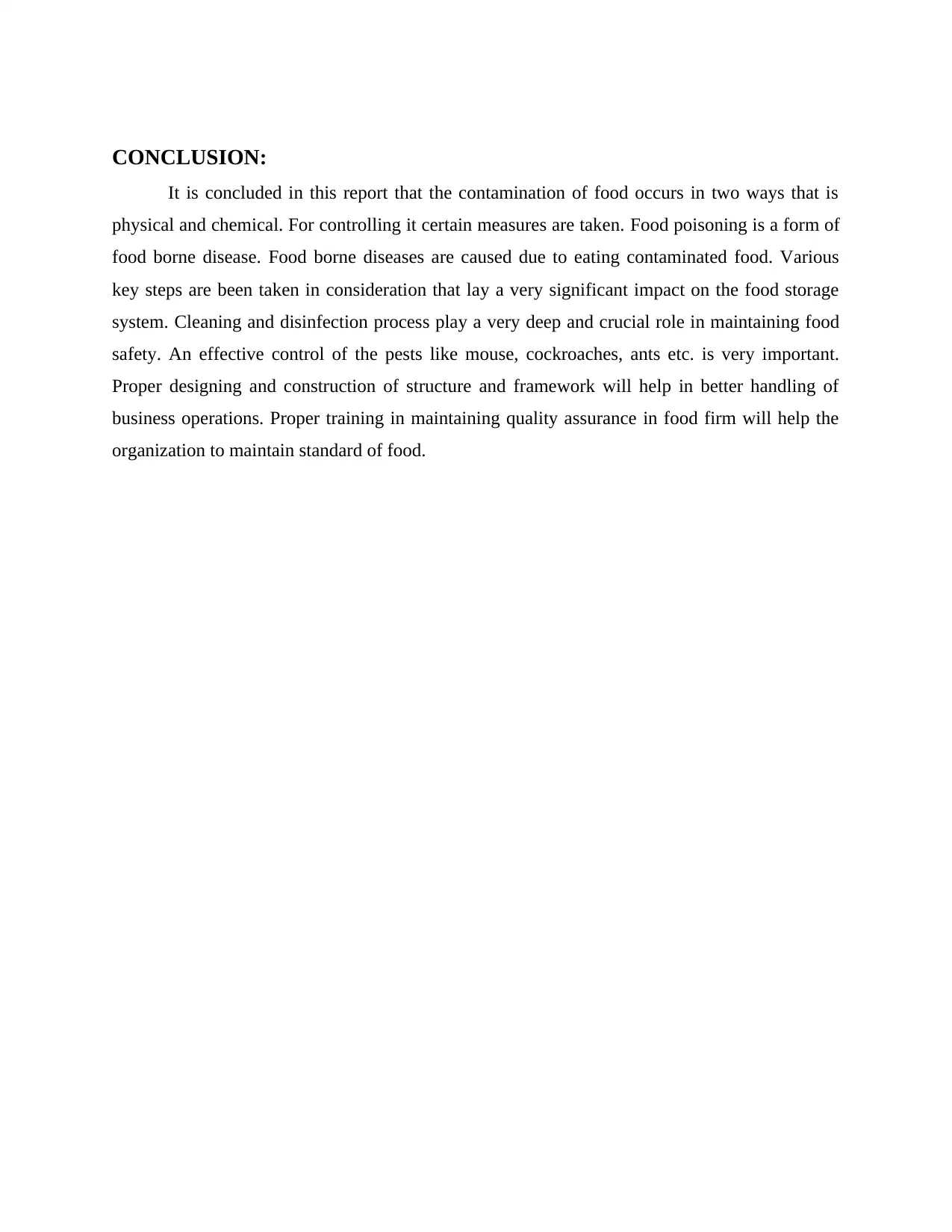
CONCLUSION:
It is concluded in this report that the contamination of food occurs in two ways that is
physical and chemical. For controlling it certain measures are taken. Food poisoning is a form of
food borne disease. Food borne diseases are caused due to eating contaminated food. Various
key steps are been taken in consideration that lay a very significant impact on the food storage
system. Cleaning and disinfection process play a very deep and crucial role in maintaining food
safety. An effective control of the pests like mouse, cockroaches, ants etc. is very important.
Proper designing and construction of structure and framework will help in better handling of
business operations. Proper training in maintaining quality assurance in food firm will help the
organization to maintain standard of food.
It is concluded in this report that the contamination of food occurs in two ways that is
physical and chemical. For controlling it certain measures are taken. Food poisoning is a form of
food borne disease. Food borne diseases are caused due to eating contaminated food. Various
key steps are been taken in consideration that lay a very significant impact on the food storage
system. Cleaning and disinfection process play a very deep and crucial role in maintaining food
safety. An effective control of the pests like mouse, cockroaches, ants etc. is very important.
Proper designing and construction of structure and framework will help in better handling of
business operations. Proper training in maintaining quality assurance in food firm will help the
organization to maintain standard of food.
Paraphrase This Document
Need a fresh take? Get an instant paraphrase of this document with our AI Paraphraser
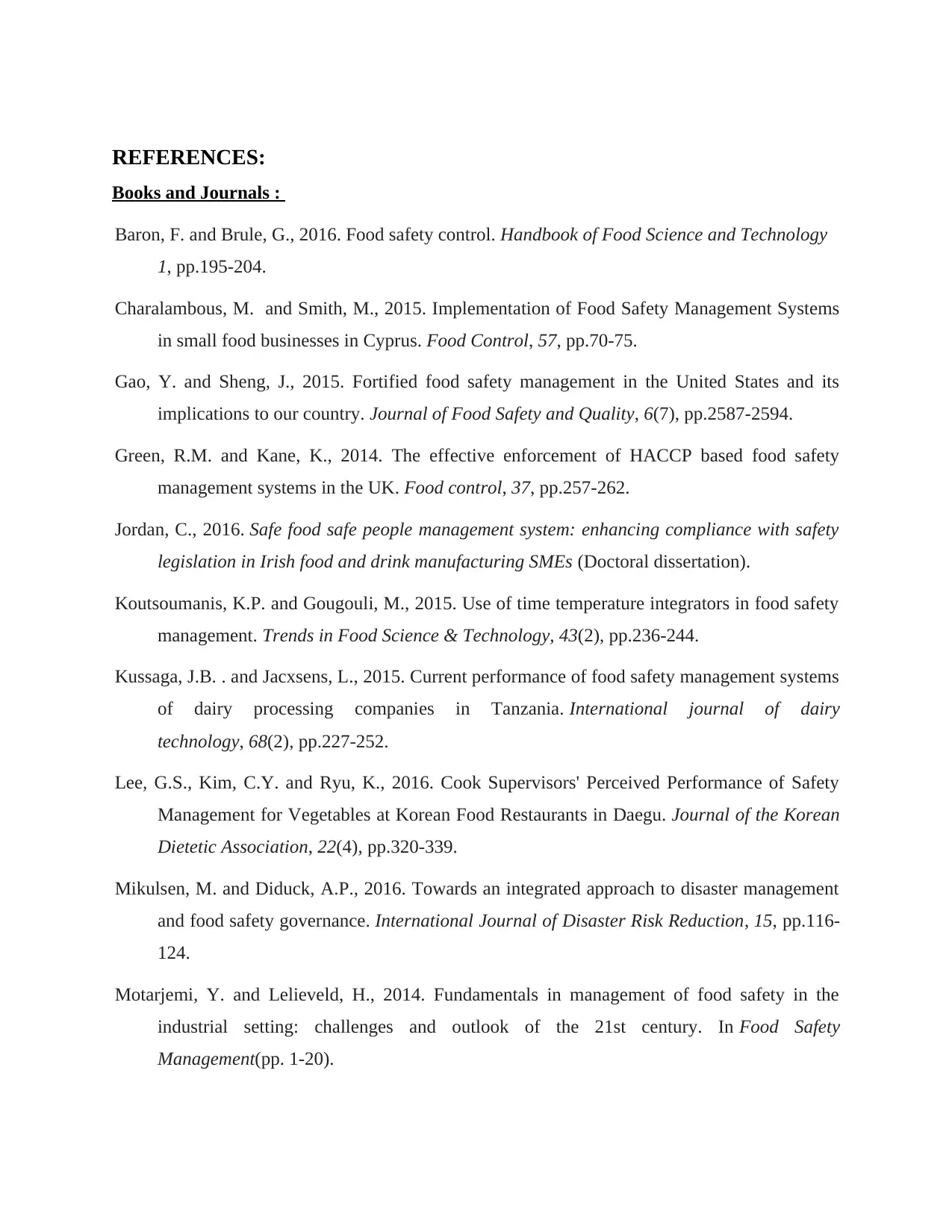
REFERENCES:
Books and Journals :
Baron, F. and Brule, G., 2016. Food safety control. Handbook of Food Science and Technology
1, pp.195-204.
Charalambous, M. and Smith, M., 2015. Implementation of Food Safety Management Systems
in small food businesses in Cyprus. Food Control, 57, pp.70-75.
Gao, Y. and Sheng, J., 2015. Fortified food safety management in the United States and its
implications to our country. Journal of Food Safety and Quality, 6(7), pp.2587-2594.
Green, R.M. and Kane, K., 2014. The effective enforcement of HACCP based food safety
management systems in the UK. Food control, 37, pp.257-262.
Jordan, C., 2016. Safe food safe people management system: enhancing compliance with safety
legislation in Irish food and drink manufacturing SMEs (Doctoral dissertation).
Koutsoumanis, K.P. and Gougouli, M., 2015. Use of time temperature integrators in food safety
management. Trends in Food Science & Technology, 43(2), pp.236-244.
Kussaga, J.B. . and Jacxsens, L., 2015. Current performance of food safety management systems
of dairy processing companies in Tanzania. International journal of dairy
technology, 68(2), pp.227-252.
Lee, G.S., Kim, C.Y. and Ryu, K., 2016. Cook Supervisors' Perceived Performance of Safety
Management for Vegetables at Korean Food Restaurants in Daegu. Journal of the Korean
Dietetic Association, 22(4), pp.320-339.
Mikulsen, M. and Diduck, A.P., 2016. Towards an integrated approach to disaster management
and food safety governance. International Journal of Disaster Risk Reduction, 15, pp.116-
124.
Motarjemi, Y. and Lelieveld, H., 2014. Fundamentals in management of food safety in the
industrial setting: challenges and outlook of the 21st century. In Food Safety
Management(pp. 1-20).
Books and Journals :
Baron, F. and Brule, G., 2016. Food safety control. Handbook of Food Science and Technology
1, pp.195-204.
Charalambous, M. and Smith, M., 2015. Implementation of Food Safety Management Systems
in small food businesses in Cyprus. Food Control, 57, pp.70-75.
Gao, Y. and Sheng, J., 2015. Fortified food safety management in the United States and its
implications to our country. Journal of Food Safety and Quality, 6(7), pp.2587-2594.
Green, R.M. and Kane, K., 2014. The effective enforcement of HACCP based food safety
management systems in the UK. Food control, 37, pp.257-262.
Jordan, C., 2016. Safe food safe people management system: enhancing compliance with safety
legislation in Irish food and drink manufacturing SMEs (Doctoral dissertation).
Koutsoumanis, K.P. and Gougouli, M., 2015. Use of time temperature integrators in food safety
management. Trends in Food Science & Technology, 43(2), pp.236-244.
Kussaga, J.B. . and Jacxsens, L., 2015. Current performance of food safety management systems
of dairy processing companies in Tanzania. International journal of dairy
technology, 68(2), pp.227-252.
Lee, G.S., Kim, C.Y. and Ryu, K., 2016. Cook Supervisors' Perceived Performance of Safety
Management for Vegetables at Korean Food Restaurants in Daegu. Journal of the Korean
Dietetic Association, 22(4), pp.320-339.
Mikulsen, M. and Diduck, A.P., 2016. Towards an integrated approach to disaster management
and food safety governance. International Journal of Disaster Risk Reduction, 15, pp.116-
124.
Motarjemi, Y. and Lelieveld, H., 2014. Fundamentals in management of food safety in the
industrial setting: challenges and outlook of the 21st century. In Food Safety
Management(pp. 1-20).
1 out of 11
Related Documents
Your All-in-One AI-Powered Toolkit for Academic Success.
+13062052269
info@desklib.com
Available 24*7 on WhatsApp / Email
![[object Object]](/_next/static/media/star-bottom.7253800d.svg)
Unlock your academic potential
Copyright © 2020–2025 A2Z Services. All Rights Reserved. Developed and managed by ZUCOL.





